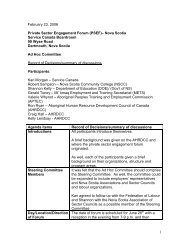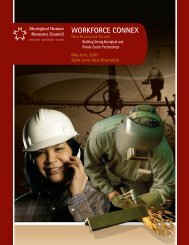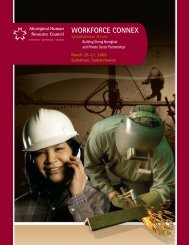Workforce connex - Aboriginal Human Resource Council
Workforce connex - Aboriginal Human Resource Council
Workforce connex - Aboriginal Human Resource Council
You also want an ePaper? Increase the reach of your titles
YUMPU automatically turns print PDFs into web optimized ePapers that Google loves.
•••••No resources to connect – no AHRDAs.Can you afford as a non-profit to compete in salaries?Volunteer planning.Economic capacity.Need long-term planning.• Need to do community mapping etc. (i.e., whatthey need right now and in the future).••The reality is that there are limited jobs in the community.Tough choices.PART 3: Circle of ChampionsThree presentations were made on successful <strong>Aboriginal</strong> individualsthat have overcome barriers to achieve a career of their choice:•••Rosa Walker, <strong>Aboriginal</strong> Leadership Institute Inc.Joel Martin, Bayview Construction Ltd.Suzette Shorting, Cormier Group Industries Ltd.PART 4: Supply Side Issues RoundtableThe purpose of this discussion was to get to know AHRDAs and the<strong>Aboriginal</strong> communities. AHRDAs were asked to be set-up as advisors tobusiness to understand the supply side. The dialogue questions were:Ask AHRDAs:What challenges and frustrations do you experiencewhen engaging the <strong>Aboriginal</strong> community?Is there anything you need to know about AHRDAs that willimprove your engagement with the <strong>Aboriginal</strong> community?What are the difficulties with recruitmentand retention of <strong>Aboriginal</strong> workers?Ask Business:How do you get the word out about your clients?Provide advice to businesses about how to overcomebarriers to positive engagement with AHRDAs?The following responses were provided by both the demand and supplysides of the labour market in response to the questions above.Supply Barriers to EmploymentWhat challenges and frustrations do you experiencewhen engaging the <strong>Aboriginal</strong> community?•Need clarification on the role, services and capacity of AHRDAs:—— Who are they?••••—— Non–Employment Insurance (EI) programs?—— Venture capital availability?—— Community specific resource programs?—— Is there any consistency?—— What resources can they really provide?—— What is the process to follow?—— Who are the agreement holders?—— What geographical area do ARHDAs cover?—— Are there accessibility limitations?—— Are they operating with funds after 15 per cent administration fee?—— Do they offer job search skills, interview skills, resume preparation?—— What are their priorities?—— Is there a database of existing trainees?—— Is there competition among AHRDAs?• Funding based on statistics – all preemploymentsupports are not counted.• Statistics count the same way for someone securing entry levelvs. someone with more training (necessary for higher positions).Information on AHRDAs:—— Not enough staff to work effectively and efficiently.—— Don’t have enough funds.—— Provide wage subsidies.—— Help to bridge life skills and traditional teachings.—— Can provide job banks.—— Help in resume building and career exploration.—— Provide education funding – outside community.—— Can offer project-based training.—— Offer employment services (resumes, interview skills), pre-screeningfor employer and links for clients – Internet job search.—— All AHRDA’s are different but offer same service.—— Pre-screening (employment agencies)AHRDAs can save employers time and money.No skilled people in communities – communication to PriorLearning Assessment and Recognition (PLAR) – certification.How do we get the word out to clients? How do we reach the people?—— Fax postings.—— Meet one-on-one.—— Brochures.10<strong>Aboriginal</strong> <strong>Human</strong> <strong>Resource</strong> <strong>Council</strong>Manitoba <strong>Workforce</strong> Connex Report









